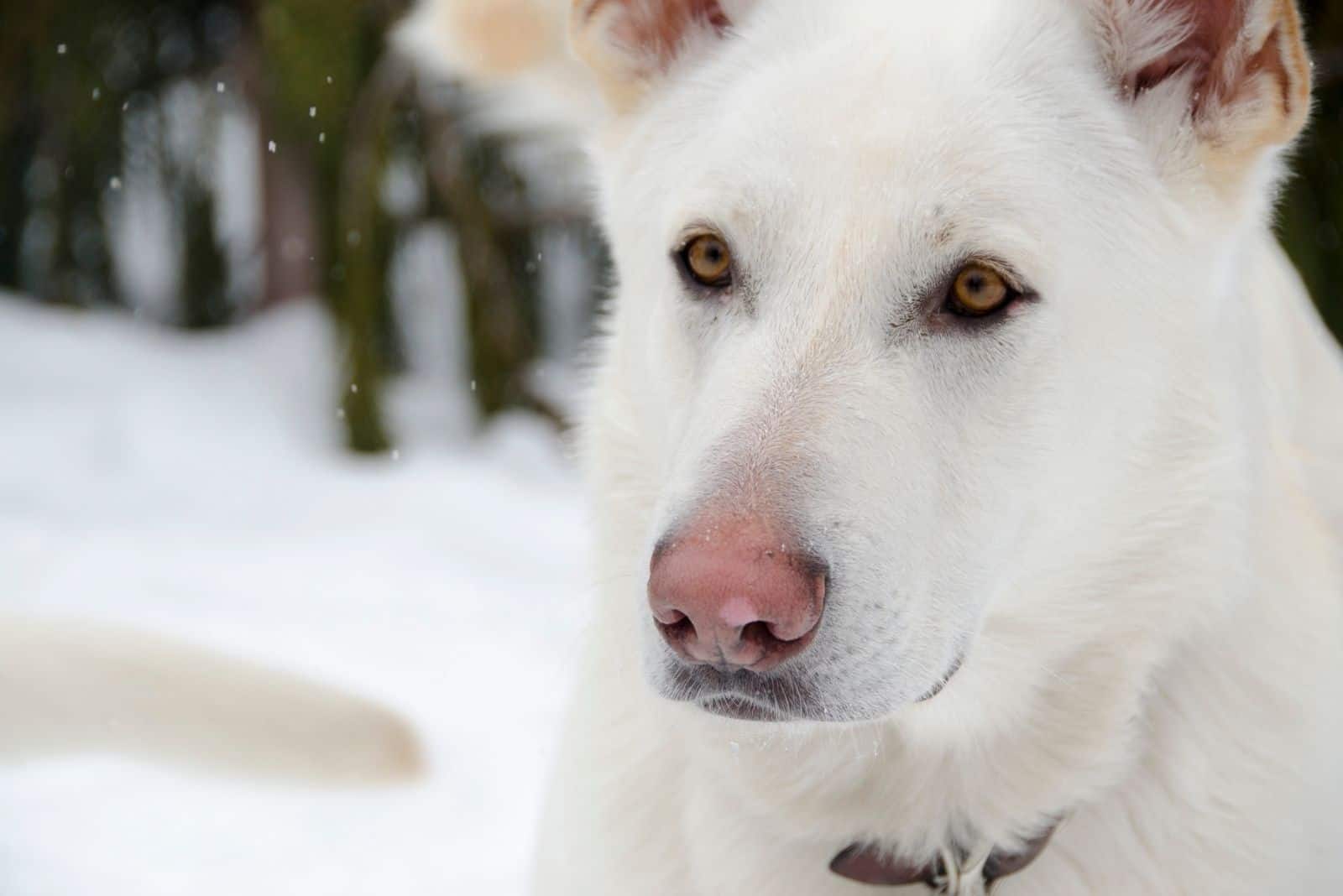When you think of a German Shepherd, you probably imagine one with the classic black and tan coat. But, did you know that they come in at least fourteen other colors, including liver, blue, isabella, sable, and white?
Some of these are rare, and others are more common. It’s all a matter of genetics, which can be a complex subject!
Basically, if a parent dog carries a certain gene, then there’s a chance that their puppies might have a coat of a particular color. We’ll go into this in more detail later, but it’s best not to dig too deeply; otherwise, we’ll get bogged down in boring scientific stuff.
In this article, we’re dealing with the Albino German Shepherd and the White German Shepherd. We’ll take a closer look at dog coat colors and how they are made, along with some of the myths and misconceptions surrounding the Albino GSD and dogs with white coats.
Let’s start with a quick overview of these wonderful dogs.
The Standard German Shepherd

Everyone knows the German Shepherd dog breed. Even if you haven’t owned a GSD, you’ll have seen them on old TV shows, at airports, out on patrol with the police, or running in the park.
These intelligent and loyal working dogs were developed from several herding dog breeds in Germany in the late 1800s, rapidly becoming popular across the globe.
They have a distinctive triangular shape, with a sharp, pointed muzzle, erect ears, a sloping back that runs down to their hindquarters, and a brush-like tail.
Although some are still used for herding, most dog owners keep them as pets. Their aptitude for training, along with their innate intelligence, makes them well-suited as service dogs, finding multiple roles with the police and armed forces.
There’s something very wolf-like about the German Shepherd dog, adding to their air of quiet confidence. They are powerful pooches, with a bite force of 238 pounds; a fact that marked them out for police work many years ago. You may have seen police dog displays where they bring down a ‘criminal’ on the run, and it’s an impressive sight.
Luckily, the runner is unharmed as they wear a special pad on their arm. Those strong jaws and teeth would do an awful lot of damage otherwise, as many a fleeing felon has discovered to their cost!
However, under normal circumstances, a properly trained and socialized German Shepherd is a wonderful family pet, and it is great with kids. This is reflected in their position at #2 in the American Kennel Club’s list of the top 200 most popular dogs.
German Shepherds are very affectionate dogs, and will lap up any love and attention you care to shower upon them.
They make excellent watchdogs and guard dogs as they are always alert and watchful. As well as being super-smart, they are high-energy dogs that need a couple of hours of exercise every day.
This might include running, walking, swimming, and playtime. All of this will help with their mental stimulation, which is equally important. Bored dogs can become restless, destructive, and even aggressive.
They are large dogs, measuring between 22 and 26 inches at the shoulder, and weighing between 50 and 90 pounds.
One drawback of the breed is its lifespan, which the American Kennel Club puts at between 7 and 10 years, although some websites claim that it is between 10 and 14.
The average for all dogs in general is 10 to 13 years. So, why does the GSD have such a short life expectancy according to the AKC? It’s possibly the result of decades of selective breeding, which narrows the gene pool and increases genetic flaws that affect the lifespan.
The GSD has a thick double coat of medium length, which sheds all year round. They’ll then blow their furry undercoat twice a year in spring and fall, so you’ll have to brush them three or four times a week. This will have to be increased to daily brushing during the shedding season unless you want loose dog hair stuck to everything!
That’s the GSD in a nutshell. Now, we’ll explore albinos and white dogs.
Albino German Shepherd vs. White German Shepherd
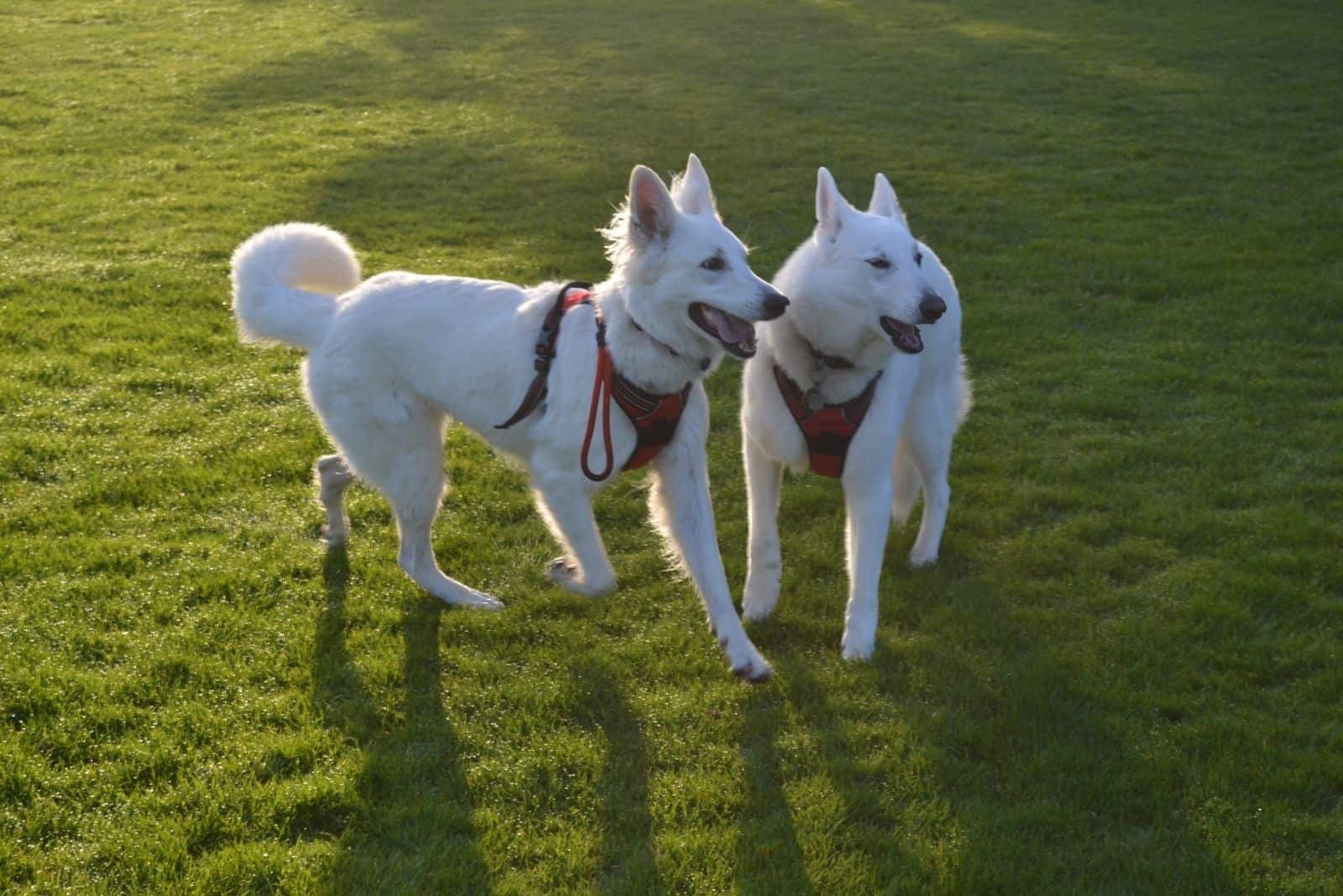
First off, they are not the same! Whatever you’ve been told, White German Shepherds are not albinos.
Albino German Shepherds do exist, but they are extremely rare. It is very unlikely that you’ll ever see one in real life.
It’s difficult enough to even find one on Google!
Let’s try to make this clearer to help you have a better understanding:
A true albino suffers from a complete lack of pigmentation, making any fur or hair brilliant white. Their skin is light pink, including their nose, and their eyes are usually pink as well (they can sometimes be blue, but this is considered a partial albino).
So, it’s a lack of color rather than a color in its own right. Albinism affects the skin, hair, and eyes, preventing the cells from producing any pigment that might give them color. Unless a dog has a pink nose, white fur, and pink skin around their eyes, it is not an albino!
The biggest cause of concern for albinos of any kind (humans included) is sensitivity to sunlight. This affects the eyes and the skin, as well as carrying an increased risk of cancer.
Albino dogs are also at severe risk of suffering from incurable eye problems, and they may be prone to other genetic defects.
What about White German Shepherds? Do they have the same problems?
First of all, their white coats are not caused by the gene that carries albinism.

Photo from: @finandfallon
White coats are caused by a recessive gene, which means that other genes usually dominate and overcome them. The only way to be one-hundred percent sure of getting White GSD pups is to breed two White German Shepherds!
However, if a Standard GSD is bred with a White GSD, they won’t have white pups.
How does this work?
Basically, dog coat colors are produced by two pigments, eumelanin, and pheomelanin.
These have default colors, with eumelanin being black and pheomelanin being red. Different genes inherited by each pup modify and dilute these colors to provide the amazing range we see today.
With the White German Shepherd, the recessive genes mask the true color of the dog, giving it a pure white coat.
They will often have dark or blue eyes and a black nose.
The same type of recessive gene also produces black German Shepherds, but in this case, it is a determinant rather than a masking gene.
What’s Wrong With White German Shepherds?
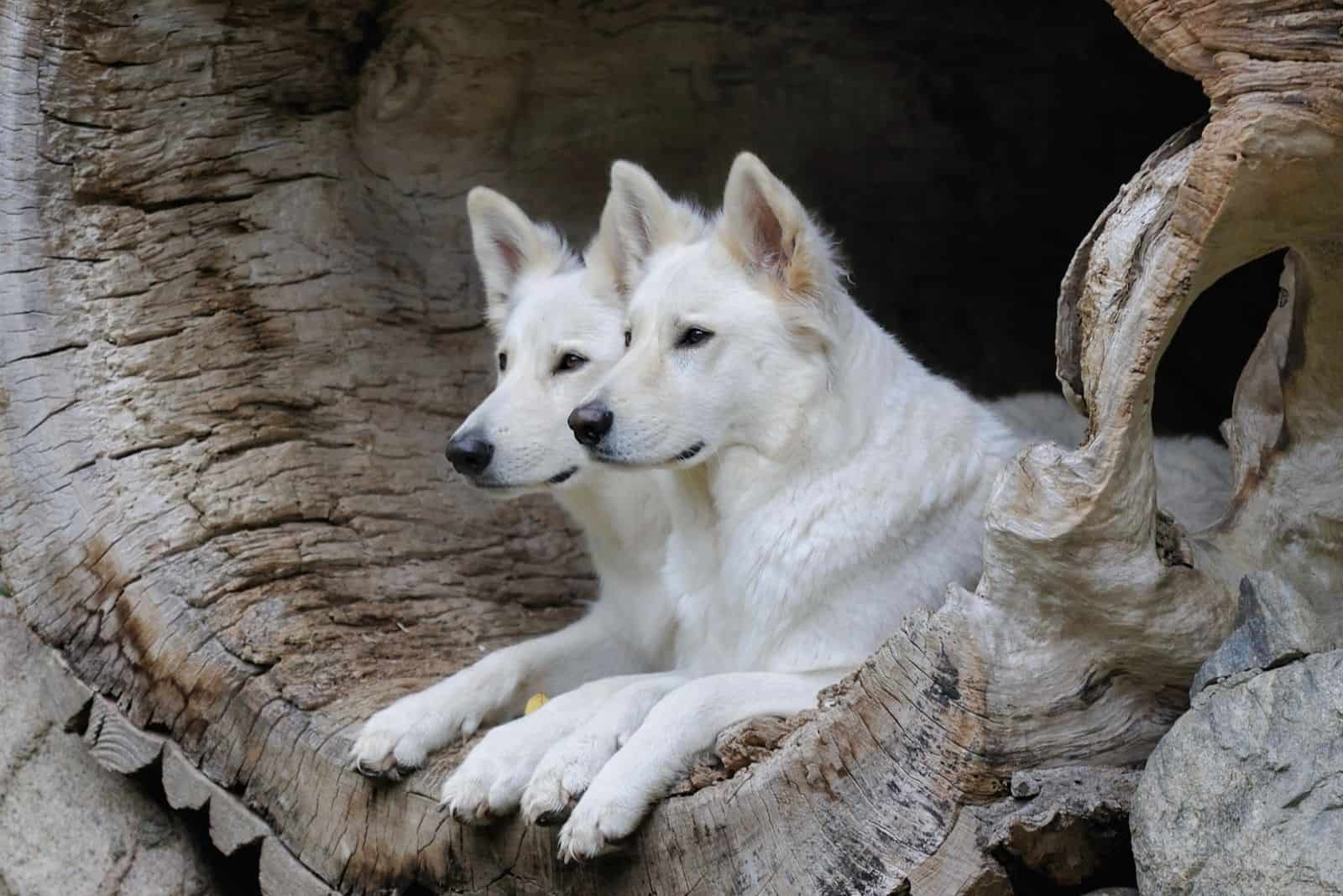
Absolutely nothing! Well, that’s to say there’s no difference between these dogs and any other type of German Shepherd.
The trouble is there’s an enduring myth that says that white GSDs, and white dogs in general, have major health problems. No one is really sure why this is, and even the person credited with the foundation of the GSD as a recognized breed, Max von Stephanitz, spoke out against this belief, saying that the color has no bearing on the matter.
It could be that people make the connection between breeds such as Dalmatians that can suffer from acute hearing problems that seem to be related to their white coats.
While it’s true that some dog breeds do have a history of deafness that is potentially connected with the gene that creates the white color, German Shepherds do not suffer from this trait.
In all other respects, White German Shepherds are identical to their colored counterparts, whether in physical attributes or in temperament.
The American White Shepherd
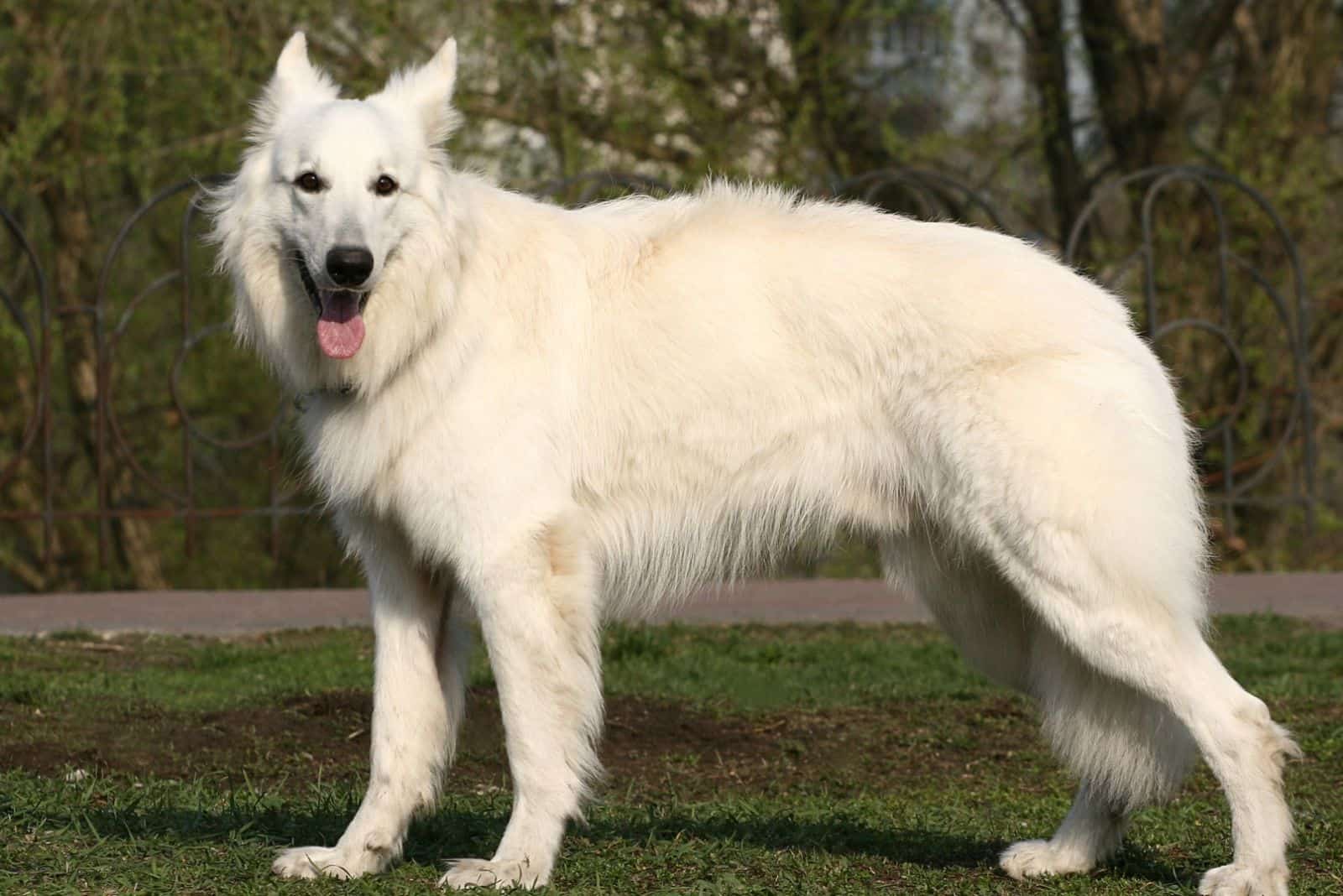
In the GSDs native Germany, the white version of this amazing dog was banned from the bloodline, and was regarded as a serious fault.
This probably added strength to the notion that they are somehow unhealthy or deficient in some way.
Some kennel clubs have reinforced this belief by refusing to recognize White GSDs. Although the American Kennel Club (AKC) allows it to be registered and lists the color white in its breed standards, it is still seen as undesirable and is disqualified from conformation shows.
This stemmed from a belief that the white color would cause fading in other colors, but this is now known to be false.
Even so, the myths persist, and white dogs of all breeds are frequently pushed aside in favor of their more colorful counterparts.
However, some enthusiasts of white-coated dogs have hit back against this trend, forming societies in America and Canada to promote and encourage the breeding of White German Shepherds. Some people even regard it as a separate breed, including several kennel clubs.
This has led to the development of the American White Shepherd, which is, to all intents and purposes, a White German Shepherd. It has effectively evolved separately from the standard German Shepherd as most breeders exclude White GSDs from breeding programs.
This fact led the United Kennel Club to list it as a separate breed, even though most other clubs and societies still regard it as a White German Shepherd.
In the end, it all comes down to your own opinion!
Incidentally, the American White Shepherd was exported to Europe where a related breed was established, called the White Swiss Shepherd.
White German Shepherd Puppies
Can you imagine anything so cute as one of these tiny white bundles of fluff?
Many of these little beauties arrive unexpectedly as they can be born to parents of any color. If both parents carry the recessive gene, then there’s a good chance that at least one of the pups in the litter will be white!
Some breeders don’t like this much as they stick to the rigid rules that identify the white coat as a fault. They probably won’t be too happy to learn that research has proven that some of the original GSDs were white!
Anyway, it’s best to have everything prepared before you bring your pup home. It’s important to let them settle in as quickly as possible and with very little fuss.
Your pup should be no younger than 8 weeks old when you buy him or her. Good breeders often keep their pups until they are around 9 to 12 weeks old as they’ll be weaned (usually by 6 weeks), and the mother will have done this naturally.
It also allows ethical breeders to evaluate the pups for any health problems and to give them a complete course of vaccinations.
White German Shepherd With Blue Eyes
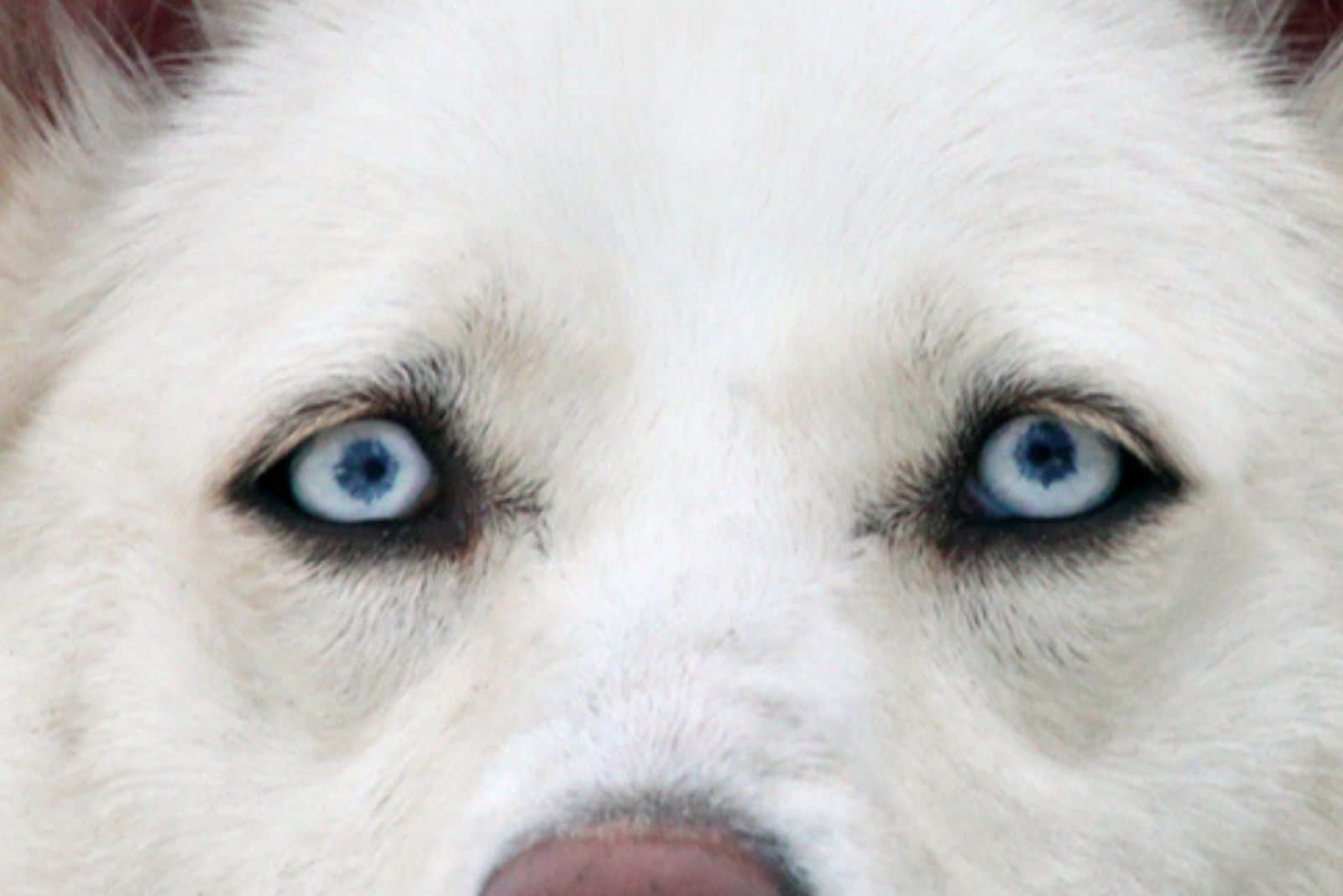
Many different white dog breeds often have blue eyes, and it usually has little to do with albinism, although, as we said earlier, some albino German Shepherds may have blue eyes.
Blue-eyed dogs with white coats are sometimes referred to as leucistic.
Here’s an interesting fact: all puppies are born with blue eyes! Actually, that’s not entirely true. The eyes just appear to be blue, but they are clear, with no pigment in the iris. The pigments that create eye color start to develop a few weeks after birth.
However, certain genes sometimes cause a lack of pigment in the eyes, resulting in a beautiful blue color that you sometimes see in White German Shepherds.
Needless to say, this is also seen as a fault, and blue-eyed dogs of all breeds are usually banned from dog shows.
White German Shepherd Price
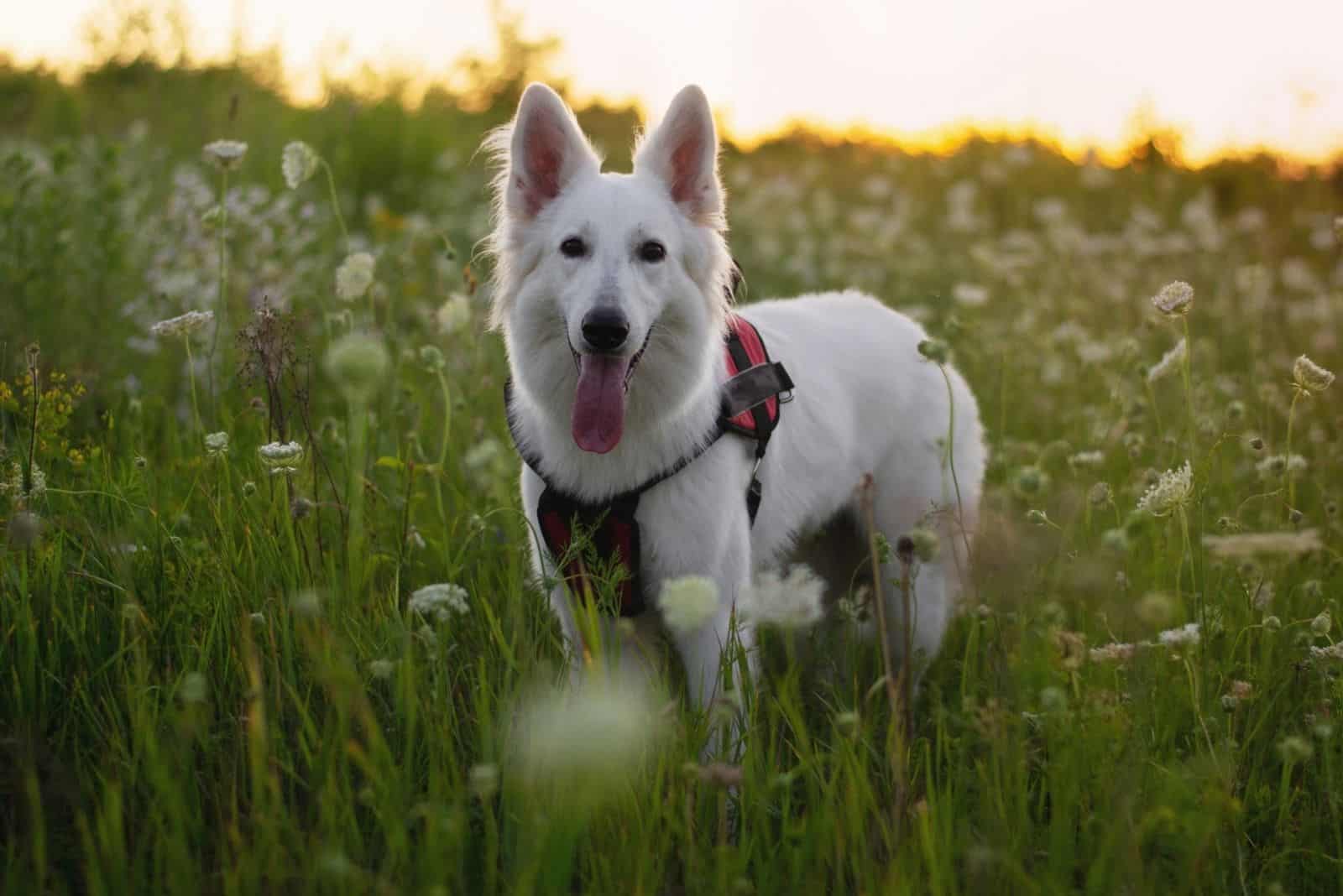
You should expect to pay between $1,000 and $1,500, but some breeders will push up the price, playing on the fact that these dogs are relatively rare. It depends on how badly you want one of these stunning dogs for yourself, but the best advice is to avoid any breeder who uses the word rare as a selling point.
In comparison, a standard German Shepherd costs between $1,500 and $3,000. This price goes steadily upward if you choose your pup from championship bloodlines.
You could find a GSD pup of any color for as little as $200, but these will not be health tested or carry any kind of guarantee.
This brings us nicely to the next section…
White German Shepherd Breeders

There are good breeders and bad ones. It’s usually not too difficult to see the difference.
Bad ones will be regarded as puppy mills because they rapidly produce litters in order to make cash as quickly as possible. Many pet stores get their stock from places like this, so it’s best to steer clear of these, too.
Backyard or hobby breeders are also best avoided. They either lack experience, knowledge, or ethics – mostly all three.
Although established, reputable breeders sometimes have their faults, but they do at least care about the welfare of their dogs. Some will be traditionalists, sticking to the breed standards of the kennel clubs they register with. This means that they may not be keen on producing or selling white dogs.
However, whether by accident or by design, White German Shepherds will appear, so don’t give up hope if you want one for yourself!
Take your time and do your homework first, and only use a breeder that you are completely happy with.
Unscrupulous breeders will sometimes try to pass off a German Shepherd mix as a purebred White German Shepherd. One of the most popular is the German Shepherd Husky mix.
Albino German Shepherd Price

Wait, people want to buy albino German Shepherds? Actually, it’s more likely that people are confusing albino with white. Nevertheless, people Google albino German Shepherd prices on average 170 times a month. And, most searches relating to albino German Shepherds return results for white GSDs, which isn’t at all helpful.
Also, there are many badly-run websites that still insist on referring to the white GSD as an albino. Here’s a clue: look at the very first photo on the website. If the dog has dark eyes and a black nose, it’s not an albino! The best advice is to leave that website immediately as any advice they have to offer is likely to be worthless.
This is frustrating, but it gives us an opportunity to clear up some misunderstandings. It also raises some ethical questions.
Let’s go over this again: in the overwhelming majority of cases, White German Shepherds are not albino!
However, on the rare occasion that an albino GSD is born, what happens to it? No reputable or respectable breeder deliberately sets out to produce albino dogs, and they would never include them in their breeding program. So, when an albino arrives unexpectedly, what does the breeder do?
Sadly, there’s a good chance that it will be euthanized rather than sold. Would you buy one? Would you be able to give it the care it needs?
White German Shepherd Temperament
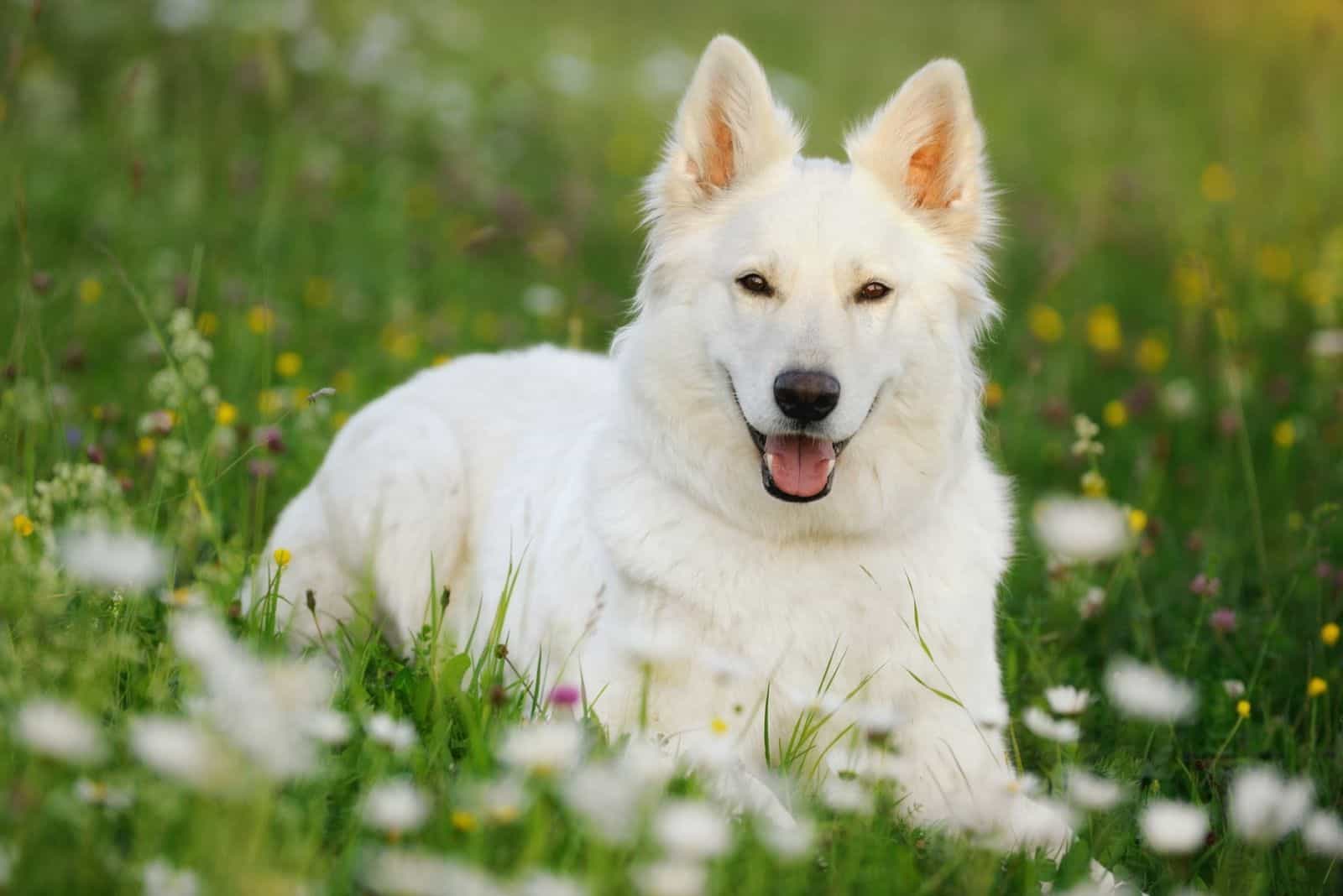
There are people out there who actually believe that white dogs are somehow more aggressive than colored ones.
It will probably not come as a surprise to hear that this is completely false and without any scientific foundation whatsoever.
At a push, you could tentatively say that an albino German Shepherd may be more prone to overreaction, but this is because they are much more sensitive and will (perhaps understandably) be more likely to lash out if they are in pain or discomfort. They certainly might be less tolerant of physical contact, which could lead to retaliation.
However, as we’ve taken great pains to spell out, White German Shepherds are not albinos!
They are intelligent, loyal, confident, and easy to train, just like the standard version of the GSD. They’re curious and courageous, alert and obedient, and they can sometimes be stubborn.
With proper dog training and socialization, they make a great family pet, and one of the best dogs you could ever welcome into your home.
White German Shepherd Lifespan
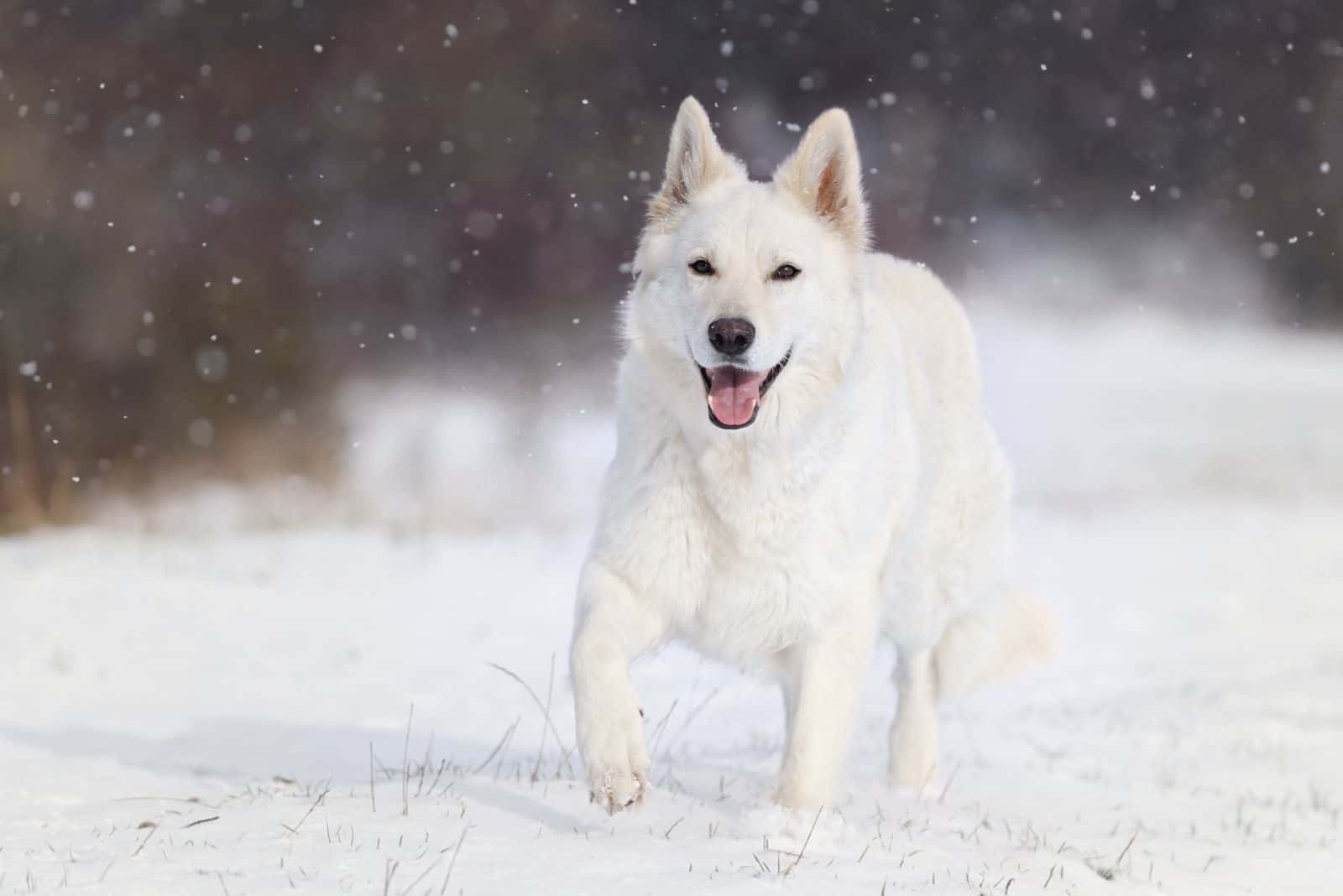
We touched on this subject earlier when talking about the German Shepherd breed in general, but it’s worth mentioning again.
The standard German Shepherd has a life expectancy of between 7 and 10 years if you accept the AKC’s figures.
However, when you look at the bigger picture, studies suggest that at least 50% of all German Shepherds die between the ages of 10 and 13. So, who do you believe?
It’s best to take a generalized view, buy your pup from a respected and reputable breeder, and then do all you can to prolong your furry friend’s life by giving them love, care, exercise, and a healthy diet of high-quality dog food.
There are no specific figures suggesting that White German Shepherds live any longer or shorter lives, although it is possible that albino German Shepherds could die at an earlier age because of increased health complications.
German Shepherd Health Issues
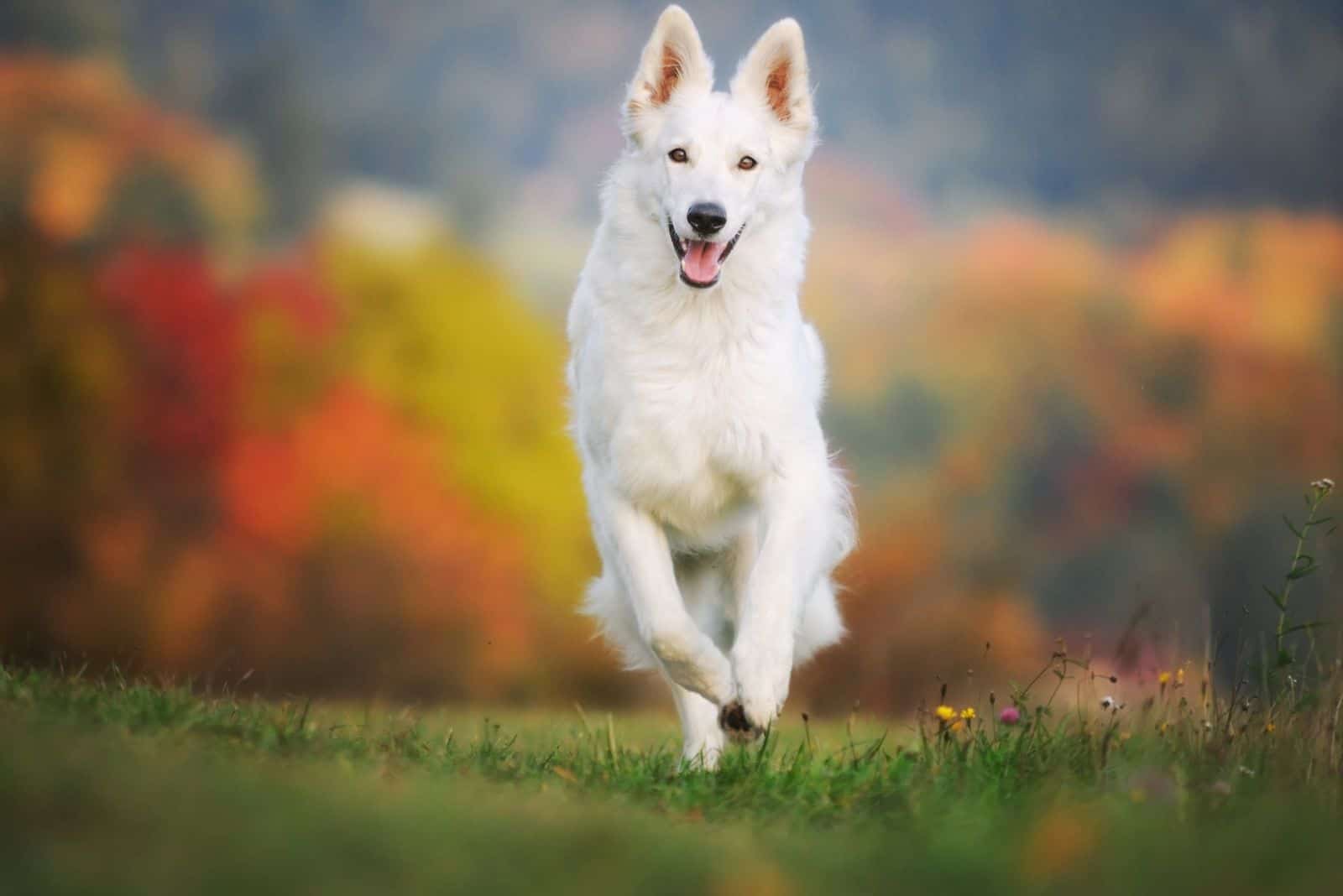
There is no evidence to prove that White GSDs are any different from other German Shepherds in terms of their health.
This means that they are equally at risk of the following problems:
• Elbow dysplasia
• Eye problems
• Hemophilia
• Epilepsy
These are among the more common problems, with the first two (hip and elbow dysplasia) probably being more frequent than the others.
As most of these are inherited, it’s always best to find a breeder who screens for these problems.
How Rare Is A White German Shepherd?
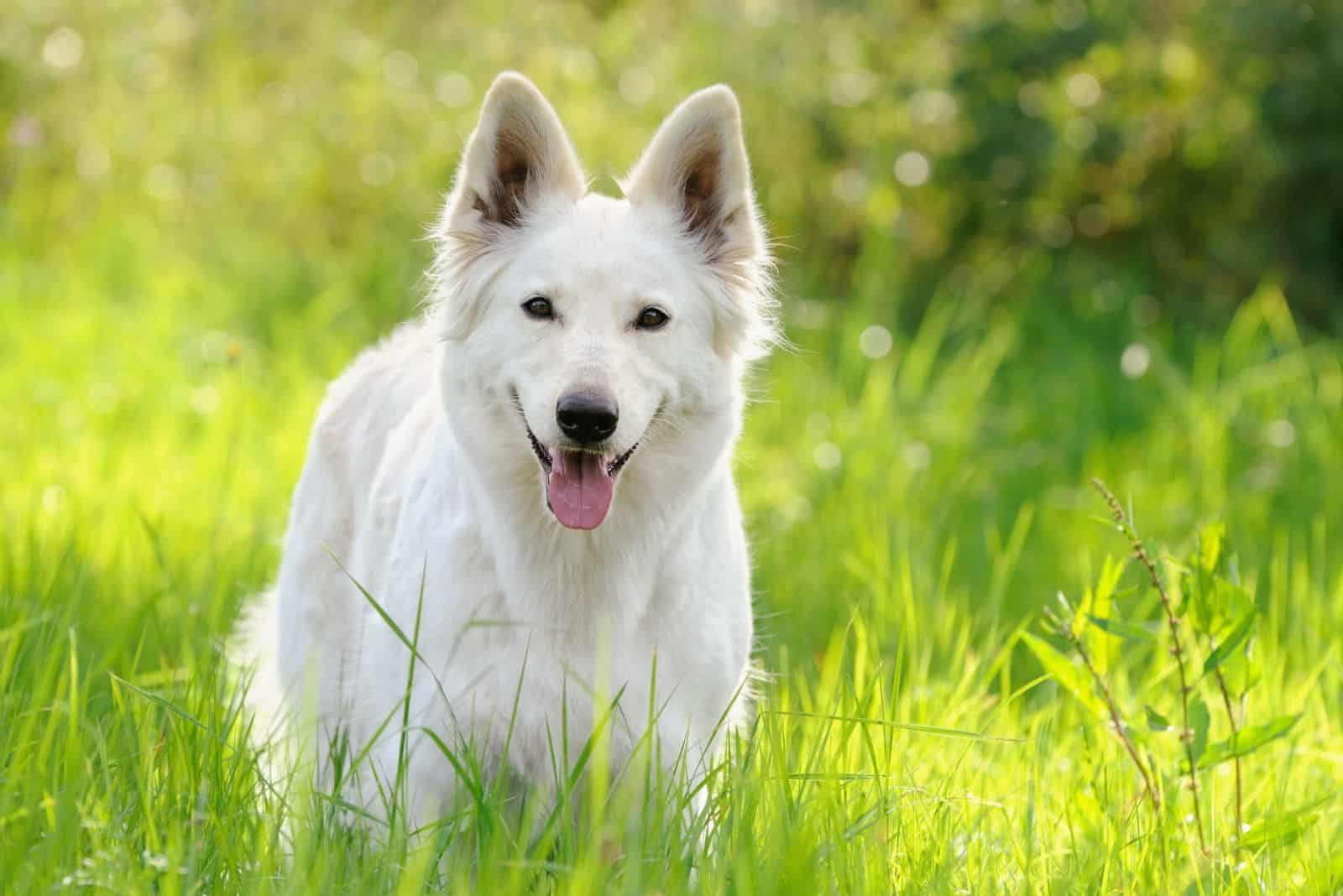
It’s probably better to say that they are uncommon rather than rare.
We’ve seen how people confuse albino German Shepherds with White German Shepherds, and how this negative association has led to them being shunned. Because of this, many breeders avoid producing or selling white pups, which is why you don’t see many around.
However, some breeders are happy to produce them because they know the truth: White German Shepherds are not albinos, they don’t have any extra health issues, and are exactly the same as Standard GSDs in every other way!
Hopefully, as the facts gradually become accepted, you’ll see more of these amazing dogs around.
The Last Word
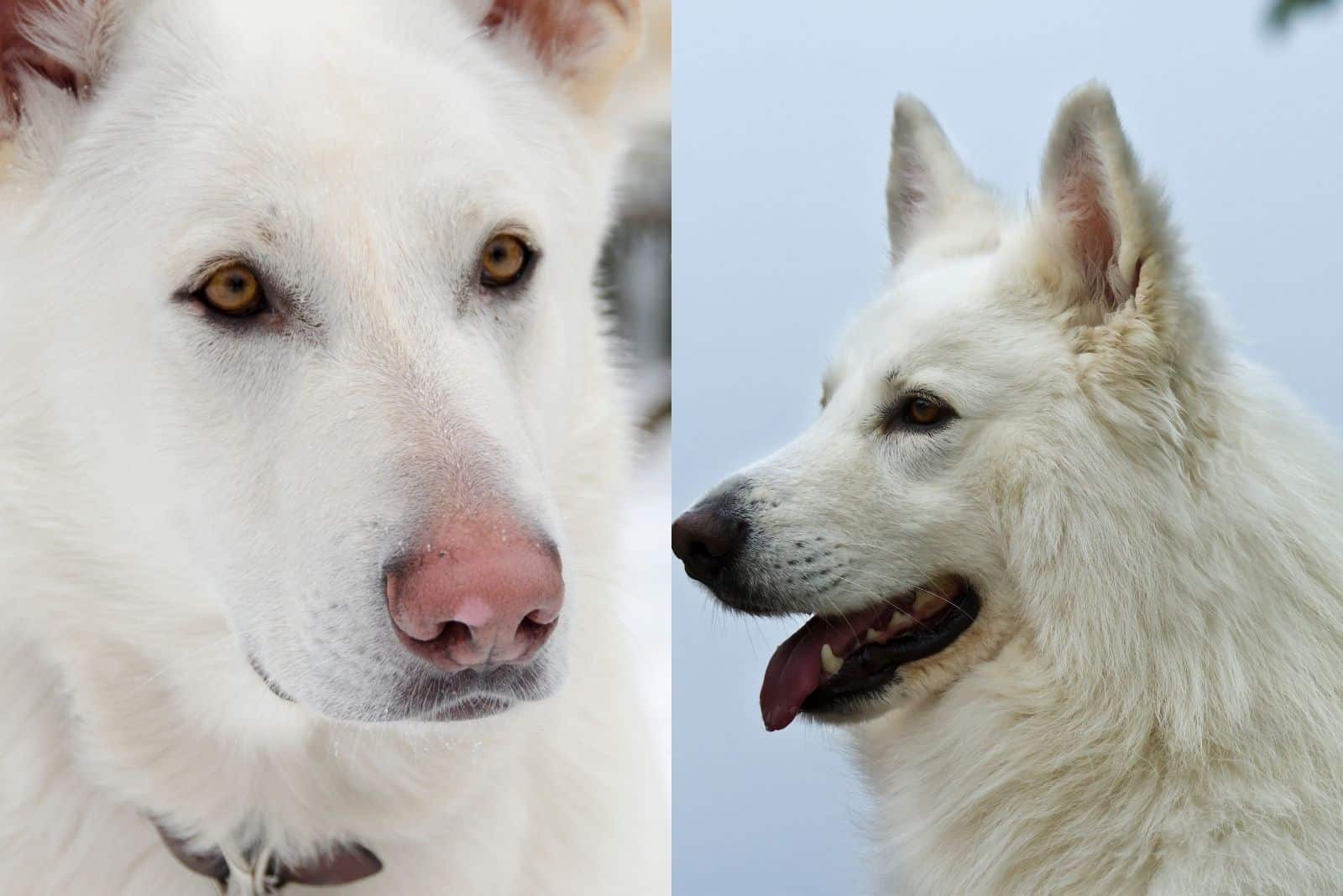
So, now you (hopefully!) have a better understanding of albino German Shepherds and the difference between them and the white GSD.
It can get complicated, especially as there are many misconceptions and different opinions on the matter.
To make things even clearer, here’s a quick summary:
• White German Shepherds (or American White Shepherds) are not albino German Shepherds.
• Albino German Shepherds are extremely rare, and they have pink or blue eyes, a pink nose, and pink skin, including the area around their eyes.
• White German Shepherds don’t have any more health problems than Standard German Shepherds.
• White GSDs are no different in terms of their character and personality.
• White German Shepherds have the same lifespan as standard ones.
Their coat color is caused by a recessive white gene, and that is the only difference between them and any other colored GSD!
Sadly, the myths about white dogs will persist as misinformation abounds on the internet, with substandard websites posting any old garbage simply to get clicks.
However, there’s (white) light at the end of the tunnel! Now that you know the facts, perhaps you could be an ambassador for the White German Shepherd?
In time to come, these beautiful dogs will be regarded no differently from German Shepherds of any other color, which is just how it should be.
